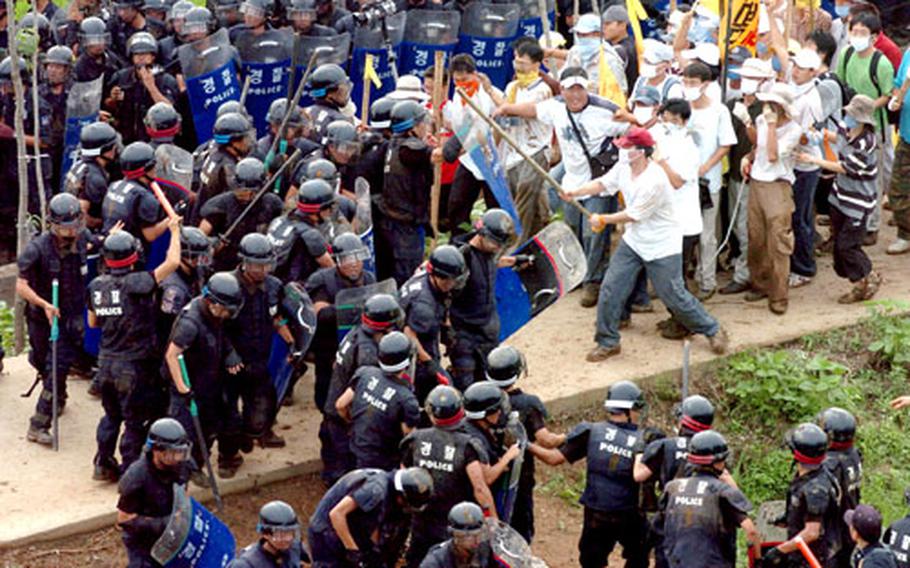
South Korean riot police battle demonstrators outside Camp Humphreys in Pyongtaek, South Korea, in July 2005. Korean National Police say 893 South Korean riot police were injured during protests last year. (F. Neil Neeley / U.S. Army)
SEOUL — Families of some South Korean riot police who guard government buildings are making a plea to their fellow citizens: When protests get out of hand, please remember that those police officers also are South Koreans.
In 2005, said the Korean National Police, 893 South Korean riot police were injured during protests, including about 100 at a summer protest in front of Camp Humphreys in Pyeongtaek and 218 during an autumn protest at the National Assembly in Seoul.
“Our young sons … don’t get the fair treatment and respect they deserve as either servicemen or police officers,” one police guard’s mother, Kim Jin-mi, said last week.
Supporters of the riot police met in January with community leaders and government officials in Seoul to seek help in raising awareness about injuries inflicted on these conscript guards during protests. They also sought a review of a system relying on young men with minimal police training to guard South Korean and U.S. government buildings 24 hours a day.
The panel, headed by Korean Prime Minister Lee Hae-chan and Ham Se-ung, a Catholic priest and activist, plans to make proposals by April addressing some of the concerns about riot police working conditions.
A USFK spokesman said no South Korean official has sought U.S. input on the subject. During large-scale protests, U.S. medical facilities are available to the South Korean guards, spokesman David Oten said this week.
About 40,000 men are in the riot police force, according to the Korean National Police. Their main job involves standing ready outside facilities including the Korean National Assembly, South Korea’s presidential residence (the Blue House), public airports, the U.S. Embassy and U.S. military bases. Guards occasionally also supplement regular neighborhood police patrols, police officials said.
Much of the guards’ eight-hour shifts involve routine gate monitoring and occasional calisthenics to stay warm. But during protests, their role quickly can become dangerous, says mother Kim Jin-mi.
In summer 2005, she launched an Internet cafe called “Riot Police, Our Lovely Sons” after her son, a riot police guard, was beaten during a large protest at Camp Humphreys in Pyeongtaek.
Kim Tae-hyung, 23, chose riot police duty over soldiering to comply with South Korea’s 26-month mandatory military service. His mother said the college photography student wanted to spend his conscription in a more urban setting where he could watch ordinary people interact.
During the 2005 summer demonstration at Camp Humphreys, protesters beat his right hand so severely that it now has begun to decay, his mother said.
Such riot police earn 65,000 won a month, about $65, a hefty raise from 2005’s monthly pay of 39,000 won. Some, like Kim, select guard duty over regular Army duty because usually it keeps them in larger cities and they must wait only about three months for an assignment, Kim’s mother said.
Kim Jin-mi said she understands why protesters can become enraged during demonstrations but not why that anger should be directed at the guards.
“If the rally is necessary, go for it,” she said. “But no matter what, any rallies that end up being violent — with weapons to hurt people — are not tolerable.”